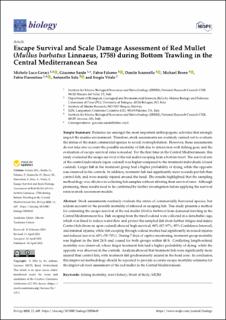| dc.description.abstract | Fisheries are amongst the most important anthropogenic activities that strongly impact the marine environment. Therefore, stock assessments are routinely carried out to evaluate the status of the main commercial species to avoid overexploitation. However, these assessments do not take into account the possible mortality of fish due to interaction with fishing gear, and the evaluation of escape survival rates is needed. For the first time in the Central Mediterranean, this study evaluated the escape survival of the red mullet escaping from a bottom trawl. The survival rate of the control individuals (open codend) was higher compared to the treatment individuals (closed codend). Larger fish in the treatment group had a higher probability of dying, while the opposite was observed in the controls. In addition, treatment fish had significantly more wounds per fish than control fish, and were mainly injured around the head. The results highlighted that the sampling methodology was effective in collecting fish samples without affecting their survival rates. Although promising, these results need to be confirmed by further investigation before applying the survival rates in stock assessment models.
Stock assessments routinely evaluate the status of commercially harvested species, but seldom account for the possible mortality of released or escaping fish. This study presents a method for estimating the escape survival of the red mullet (Mullus barbatus) from demersal trawling in the Central Mediterranean Sea. Fish escaping from the trawl codend were collected in a detachable cage, which was lined to reduce water flow and protect the sampled fish from further fatigue and injury. Control fish (from an open codend) showed high survival, 94% (87–97%, 95% Confidence Interval), and minimal injuries, while fish escaping through codend meshes had significantly increased injuries and reduced survival, 63% (55–70%). During 7 days of captive monitoring, treatment group mortality was highest in the first 24 h and ceased for both groups within 48 h. Conflicting length-related mortality was observed, where larger treatment fish had a higher probability of dying, while the opposite was observed in the controls. Analysis showed that treatment fish were significantly more injured than control fish, with treatment fish predominantly injured in the head zone. In conclusion, this improved methodology should be repeated to provide accurate escape mortality estimates for the improved stock assessment of the red mullet in the Central Mediterranean. | en_US |
